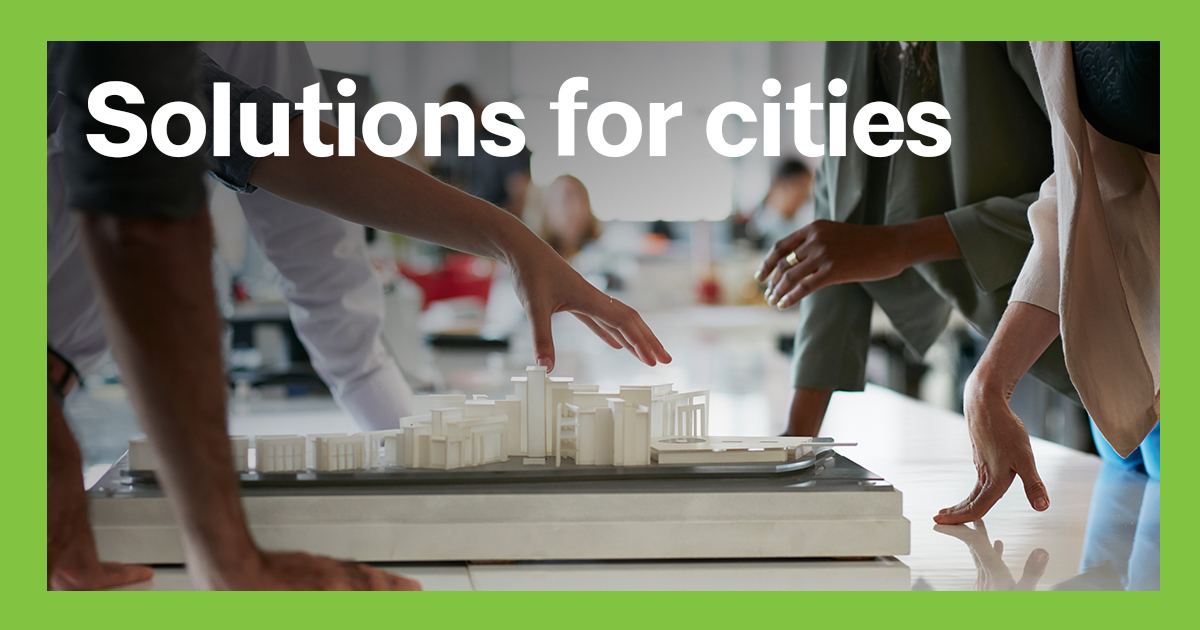
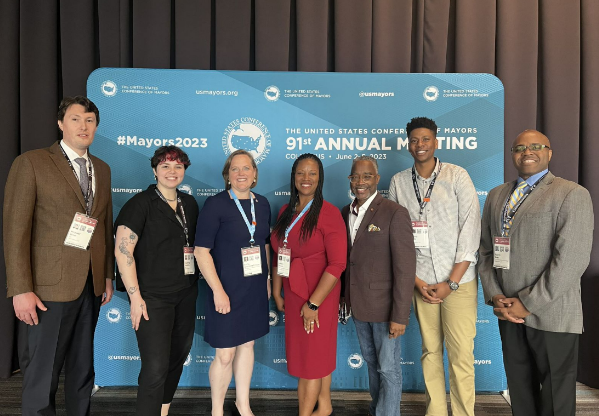
Caption: AIA staff and leaders attend the U.S. Conference of Mayors 91st Annual Meeting in Columbus, Ohio. L to R: Michael Winn, Sr. Director, State & Local Advocacy; Courtney Hawkins, Manager, Digital Content; AIA President Emily Grandstaff-Rice, FAIA; AIA CEO/EVP Lakisha Ann Woods, CAE, Kevin Holland, FAIA, chair, AIA’s Government Advocacy Committee. Darral Tate, Assoc. AIA, co-chair, AIA’s Public Awareness Committee, and Davon Gray, Managing Director, Advocacy and Engagement.
Before AIA leaders arrived at the U.S. Conference of Mayors 91st Annual Meeting, AIA architects were already serving city leaders by addressing issues on sustainability and resilience in the built environment in cities across the United States.
In Kansas City, AIA supported and worked with city leaders to ensure that energy efficiency and resiliency standards were not watered down during the recent building energy codes update. Adopting the latest building codes saves building owners and tenants money on their utilities, reduces negative health impacts, and saves $11 for every $1 spent by mitigating recovery from future natural disasters.
In Columbus, AIA members participated in the Buildings Task Force to shape the cities’ climate action plan and meet its goal of being carbon neutral by 2050 and reducing greenhouse gas emissions by 45% by 2030.
Houston has a Climate Action Plan with a focus on resilience and sustainability plans for the city. Houston Mayor Sylvester Turn spoke with AIA’s CEO/EVP Lakisha Ann Woods, CAE, about how the program was going.
These impactful partnerships inspired AIA’s role in the 2023 conference, recently held in Columbus, Ohio. Woods addressed the conference. AIA President Emily Grandstaff-Rice, FAIA, served on two panels, as did Kevin Holland, FAIA, chair, AIA’s Government Advocacy Committee. Darral Tate, Assoc. AIA, co-chair, AIA’s Public Awareness Committee, also attended the conference.
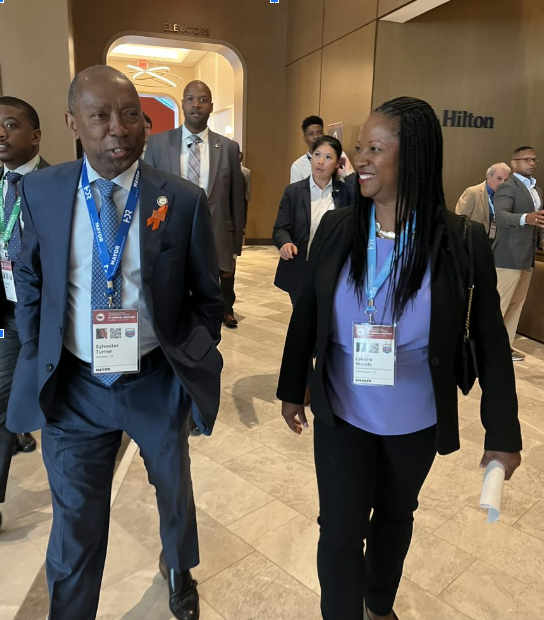
Caption: Houston Mayor Sylvester Turn spoke with AIA’s CEO/EVP Lakisha Ann Woods, CAE, at the U.S. Conference of Mayors 91st Annual Meeting in Columbus, Ohio.
“Architects have the skills and expertise to work with mayors to deliver results that improve the quality of life and create places where individuals can thrive regardless of their zip code,” Woods shared.
AIA’s presence at the conference was an opportunity to strengthen relationships with U.S. mayors and other elected officials and business leaders to advocate for architects to have a role in guiding design projects and consulting on the most efficient ways to produce quality, community-centered designs.

Caption: AIA’s CEO/EVP Lakisha Ann Woods, CAE, speaks to attendees at the U.S. Conference of Mayors 91st Annual Meeting in Columbus, Ohio.
“Architects design the places that make cities work. As you seek progress in your cities, architects are the perfect partners,” said Woods. “If your city does not have a Chief Architect, this is the perfect time to put one in place.
Community-based climate action
Climate action was one of the top issues discussed at the conference. Grandstaff-Rice moderated a panel featuring Mayor Andrew Ginther from Columbus, Ohio, and New Orleans Mayor Latoya Cantrell. The panel, Advancing Climate and Equity Plans - A Framework for Community Design Excellence, gave Grandstaff-Rice the opportunity to spotlight AIA’s Framework for Community Design.
“Architects, like mayors, envision the future, and we know how to get there,” said Grandstaff-Rice.
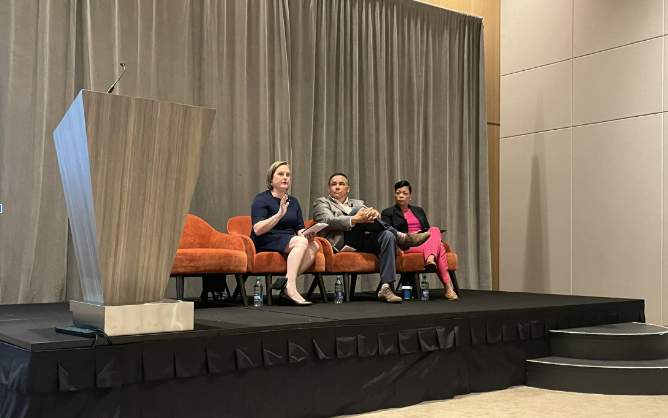
Caption: L to R: AIA President Emily Grandstaff Rice, FAIA, moderates a panel on climate change with Mayor Andrew Ginther from Columbus, Ohio, and Mayor Latoya Cantrell from New Orleans, La., at the U.S. Conference of Mayors 91st Annual Meeting in Columbus, Ohio.
This session focused on ways mayors are utilizing climate action plans to reduce risk, address affordability and improve health outcomes. Mayors seeking to establish community-based climate goals, create a new climate action plan or implement an existing plan attended to learn more about specific building-related issues to consider throughout this process. Grandstaff-Rice also called on mayors to consider establishing a Chief City Architect position, someone responsible for developing and implementing the design vision for their city’s future.
Grandstaff-Rice also served on the panel Vacant Commercial to Occupied Residential: Reimagining Commercial Space as Housing, joined by Mayor Luke Bronin, of Hartford, Conn., Mayor Corey Woods, of Tempe, Ariz., Mayor Jacob Frey, of Minneapolis, Minn., and Mayor Wade Kapszukiewicz, Toledo, Ohio. This panel gave sharp focus to the challenge communities are facing to offer residents affordable housing. Grandstaff-Rice encouraged mayors to prioritize refurbishing or adapting properties in their towns to create more affordable and sustainable housing.
“The greenest building is probably the one that’s already built,” said Grandstaff-Rice.
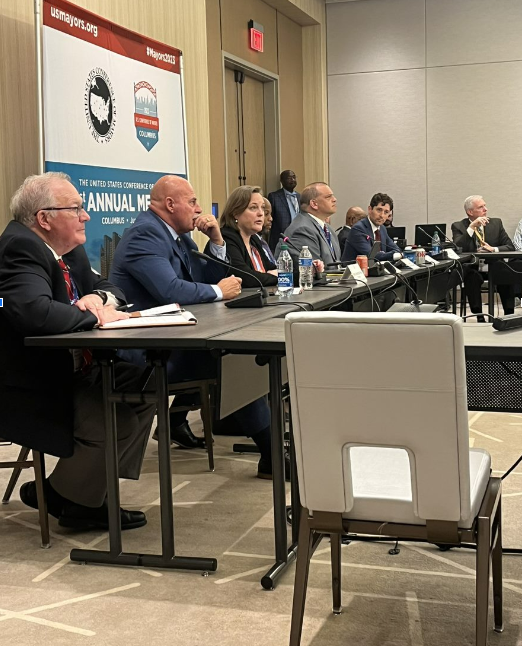
Caption: AIA President Emily Grandstaff-Rice, FAIA (center) speaks on a panel addressing affordable housing at the U.S. Conference of Mayors 91st Annual Meeting in Columbus, Ohio.
Partners in progress
AIA leaders learned mayors are eager to work with architects. Mayors are looking for partners to help create solutions for the complex problems in the built environment. AIA will continue positioning architects and AIA components as partners with city leaders, discussing the benefits of mayors working with architects, and advocating policies that align with AIA's commitment to climate action and racial and gender equity.
Reach out to your state or local component and ask how to get involved in advocacy in your community. Learn more about AIA’s Blueprint for Better campaign and discover the many ways architects can help